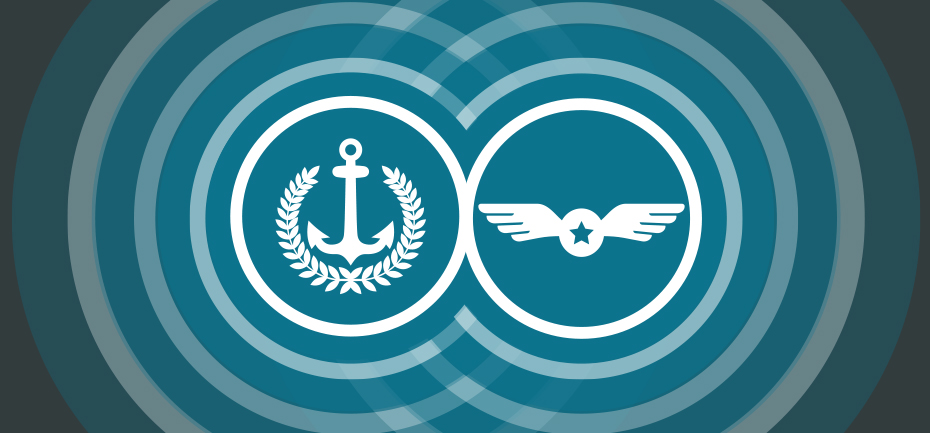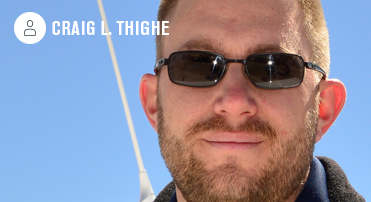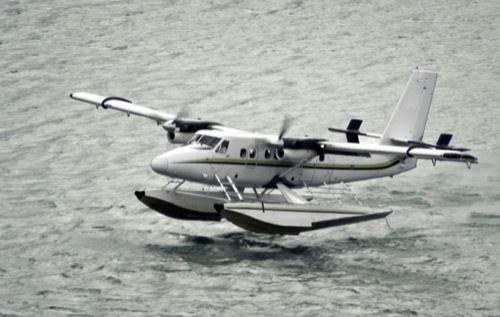Craig L. Thighe
Craig L. Thighe is a research solutions strategist at Jeppesen Digital Aviation in Englewood, USA. He had his first flight lesson at age 15, but always knew he wanted to fly. "I remember when an airline pilot came to talk to my elementary school class. He had a poster with a mock-up of a cockpit on it and it immediately hooked me. I knew at that point that I wanted to be a pilot."
Although Craig is the first licensed pilot in his family and first to join what he calls "the select community of aviators," his grandfather was in the Royal Air Force (UK). Flying's main appeal is learning a skill that few people have, says Craig, "There is something exciting and powerful about flying an aircraft. It's about mastery, precision and being a professional." He also appreciates seeing some truly fantastic sights: "Sunrise at 35,000 feet is something you never tire of!"
The demands on a pilot to stay updated and fly safely are many. In-flight tasks are endless and preparations meticulous. Craig also mentions the more personal challenges, such as missing holidays, family events and other personal activities due to being on call.
Craig has seen technology advance at a rapid rate in the aviation world during his career. "Cockpits have become more complex, but technology makes the pilot significantly more aware of the 'big picture.' New tools have totally changed the way we operate, tablet computers have drastically changed the way we view and get information for our flight."
Although he now works on the ground as a research solutions strategist for Jeppesen, Craig still teaches flying and is an accredited pilot examiner. "I came to Jeppesen from a full-time flying job and found that I love the opportunities it's afforded me. It's also allowed me to focus on one of my favorite aviation activities, which is teaching people to fly. I love providing aviation education and watching people become better and safer pilots."
Does he have a professional memory to share with his grandchildren? "It must be having the opportunity to fly at 49,000 feet, which is over nine miles above the earth."
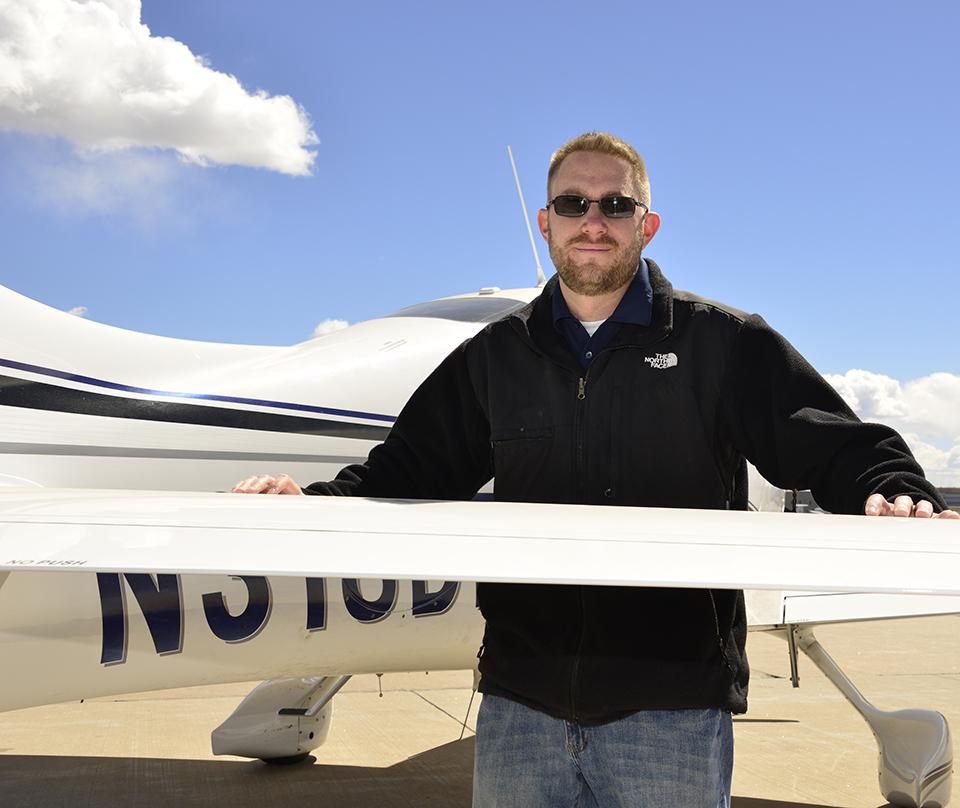
Craig L. Thighe
A pilot for over 15 years, Craig has flown more than 150 different aircraft, logging 3,500 flight hours. He is a CFI, CFII, MEI, ATP and holds an HS-125 type rating. He is also a Designated Pilot Examiner (DPE) and Gold Seal Flight Instructor. A Jeppesen employee for the last 12 years, Craig currently supports the Market and Solutions Research team working on the next generation of aviation solutions.
Craig has captained Learjet 35 and Hawker 700 corporate jets of around six metric tons and with a price tag of $3.1 million.
More information: Craig L. Thighe
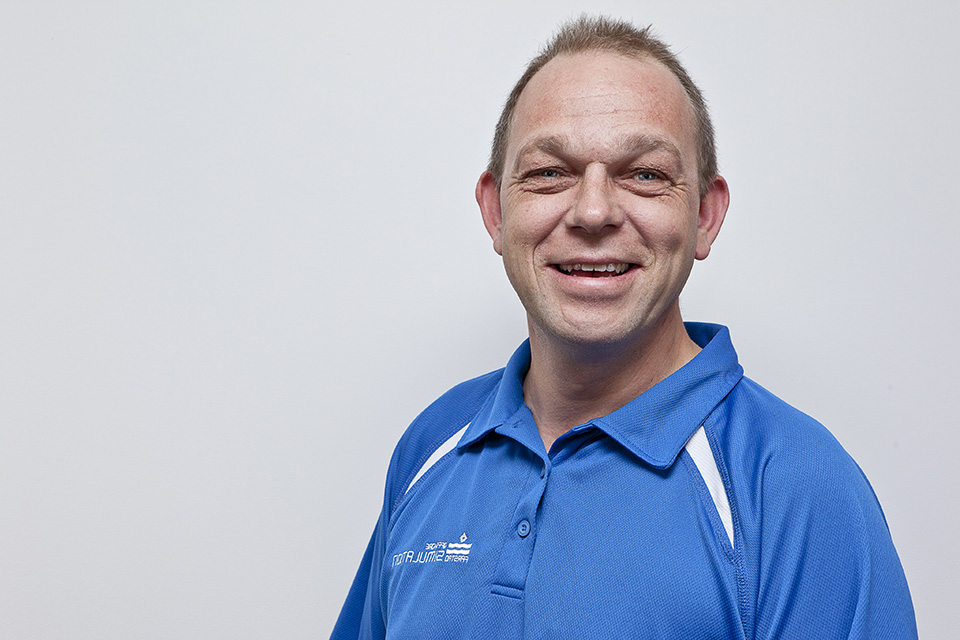
Sigmund Hammersland
Sigmund has 28 years at sea, 20 as a captain, and received his Deck Officer Class 1 in 1997. As captain on trawlers and AHTS vessels, he has experience from West Africa, the North Sea and the Norwegian Sea. An offshore instructor since 2008, Sigmund is now based at Farstad's Offshore Simulation Centre in Perth, Australia.
He has captained AHTS vessels, which are generally on long-term charter or spot charter to oil and offshore companies. Norwegian sector AHTS vessels are between 4,500-7,000 tonnes with price tags of $100-180 million.
More information: Sigmund Hammersland
A CAPTAIN'S WORK
So how do our two captains' working lives compare and contrast?
Sigmund Hammersland
Sigmund Hammersland is an offshore instructor at Farstad Shipping's offshore simulation centre in Perth, Australia. He gained his sea legs at an early age, starting work on a fishing trawler straight after leaving school. He has a very pragmatic view of the appeal of a life at sea. "My whole family worked as sea captains, engineers or deckhands, so I didn't really consider doing anything else. But the money and getting six months leave every year were also factors."
After completing a nautical education, he later ventured into offshore as a captain on anchor handling tug supply (AHTS) vessels. There, his 20 years of fishing experience became particularly relevant: "On an AHTS, using massive winches and high-tension cables to tow rigs, a captain must be keenly aware of the forces and tension experienced by the vessel, an ability I had already acquired aboard trawlers." A trawler captain's wide-ranging skills and ability to make split-second decisions also played in Sigmund's favor.
Sigmund confirms that life at sea isn't always conducive to a good home and family life. "When I started, I was at sea 330 days a year and you needed a very good reason to take time off." Although this has changed, his advice is nevertheless to acknowledge that whereas a captain may be the boss at sea, his wife is always the boss at home.
Sigmund's family focus was also the reason for his latest career move, becoming an offshore trainer based onshore. He needed to "spend more time with my wife, son and two daughters," − a big move, involving relocating from Norway to Perth in Australia. In addition to improving his domestic situation, it's also been a professional success.
"I teach on offshore and ECDIS to both industry novices and veterans, meeting new people every day. It's another way to do the job I did in the North Sea, in a new country and culture, and I enjoy it."
And Sigmund's professional memory to share with his grandchildren: "Maybe that I helped move what was then the world's biggest rig, Deep Sea Atlantic" (Odfjell's ultra deepwater and harsh environment drill rig).
WORK & LEISURE
Craig L. Thighe
Most current aircraft utilize two crew members, and for long overseas trips a second full crew may be on board to relieve the flying crew when they reach their duty time limits. If you're flying for a corporate or private operator, you'll usually work with the same crew. If you're working for an airline, your crew rotates as your schedule changes. We use standardized training, checklists and flows for consistency.
Sigmund Hammersland
An AHTS vessel may have around 18 crew: four on the bridge, four in the engine room, six on deck, and two in the galley. Then there are three trainees, one each for engine, bridge and deck. The crew will typically only be a third of the entire workforce onboard, which can number up to 60. We usually have a stable crew, but because of all the new buildings, crews are being taken from several vessels. Good teamwork is essential for anchor handling.
TEAMWORK
Craig L. Thighe
The pilot's work rotation depends on the type of flying they do. A corporate pilot could have just a few days off a month or a whole month off at a time. The longest long-haul flights, e.g. 8,575 miles from Sydney to Dallas, can take 16 hours. These trips can last up to a week or more. Short-haul flights can last anywhere from 30 minutes to three hours. Medium haul is defined as three to six hours.
Sigmund Hammersland
An AHTS vessel works a four-week "swing," during which it can be in port up to seven times. A typical voyage for an AHTS in the North Sea is from harbor to a rig, do the disconnect, tow the rig to a new location, reconnect and sail back, which normally takes a few days. A tow from the North Sea down to Africa or Australia could take four weeks.
SAFETY
Craig L. Thighe
Aviation poses many safety challenges. The captain's role is to identify and manage potential safety issues. In the airline world we are always concerned about terrorism, especially after the September 11th attacks. Most aircraft have traffic/collision avoidance systems built in, but pilots are still responsible for "seeing and avoiding" and we do extensive safety training/drills both in aircraft and using simulators.
Sigmund Hammersland
On an AHTS vessel, it's always safety first. You need to do proper risk assessment, you need work permits; there is a system for everything safety related. There are two critical safety aspects, deck work (for crew risk) and when we have a lot of tension on the winch (ship risk). When you have tension on the ship, it's part of the risk assessment - you need to show the oil company that you've done your stability calculations. The tension loads when you tow a rig are up to 130 tons, but when you do anchor handling, when you prelay, we tension the anchors up to 400 tons of torque.
COMMON CHALLENGES
Craig L. Thighe
Fatigue and complacency are big issues for pilots and something that the Federal Aviation Administration and industry are working to address. Flying can be repetitive and with automated systems it is easy to get bored. Stress is another a big factor for pilots, especially when weather challenges present themselves. To manage day-to-day stress, pilots have to develop their own habits and strategies, such as personal checklists and relaxation techniques.
Sigmund Hammersland
Fatigue is a challenge on an AHTS vessel when you do a rig move, as you are usually always on call and it's not possible to get enough rest. The captain especially is always on watch. His responsibility for managing a large crew and a set of high-tension cables and winches can create a fairly stressful situation sometimes. But when you have more experience, you become more relaxed about it.
AHTS captains also have special weather and sea-state challenges. When connecting and disconnecting a rig, safe limits are 30 knots of wind and three-point-five-meter wave height. But if you are towing a rig and a hurricane blows up you have to tow regardless. You then have an emergency backup, e.g. detouring into fjords to wait out the weather, if the weather forecast predicts more than seven-meter significant wave height.
RESPONSIBILITY & REWARDS
Craig L. Thighe
A corporate captain is responsible for the safe operation of the aircraft and management of crew members and also has final authority for the flight. A corporate captain earns around USD 125,000, an airline captain up to USD 200,000.
Sigmund Hammersland
Besides excellent boat-handling skills, an AHTS captain has to manage his deck, engineering and bridge crew, ensure procedures and safety, do all the administration and maintain communication with both client and shoreside management. Of course, you have to delegate some of this to the Chief Officer. An AHTS captain's salary varies regionally. In the North Sea it's between USD 130,000 and 200,000; in Australia it's around USD 240,000.
TECHNOLOGY
Craig L. Thighe
Newer aircraft are usually fitted with electronic flight bag capability, which provides the operator with a full set of digital/electronic charts. We use flight-planning/routing software to help determine optimal routes and for fuel optimization. Most aircraft are equipped with weather radars for making tactical weather decisions. Aircraft that have a weather data subscription allow us to look at weather along our route of flight and make strategic decisions before we reach our destination.
Sigmund Hammersland
Technology onboard AHTS vessels is always top of the range. Farstad has decided to have ECDIS on all its vessels, even those below 3,000 tons, and is actively transitioning its mariners over from paper charts to ECDIS. Weather data technology is especially important when an AHTS does a rig move. The captain will usually source data from two different suppliers and supplement this with his own calculations, updating and analyzing this every six hours. He also makes frequent use of routing software and voyage/fuel optimization technology, in accordance with the oil companies' efficiency and safety vetting routines. For ship-shore
communications an AHTS uses satellite phones and email, and sometimes MF, HF and VHF.
POWERED BY NATURE
Craig L. Thighe
Air captains can use the jet stream to fly faster, but it also slows them down when eastbound, especially in the winter. The extra speed/resistance is somewhere between 80-140 mph.
Sigmund Hammersland
AHTS captains always make use of ocean currents, especially when doing a rig move. In the North Sea and West of Shetland, the current heads north, from half a knot up to four knots, so we use the Gulf Stream. You have to work with it, but sometimes it works against you as well. One knot of current is like 10 or 12 knots of wind.

